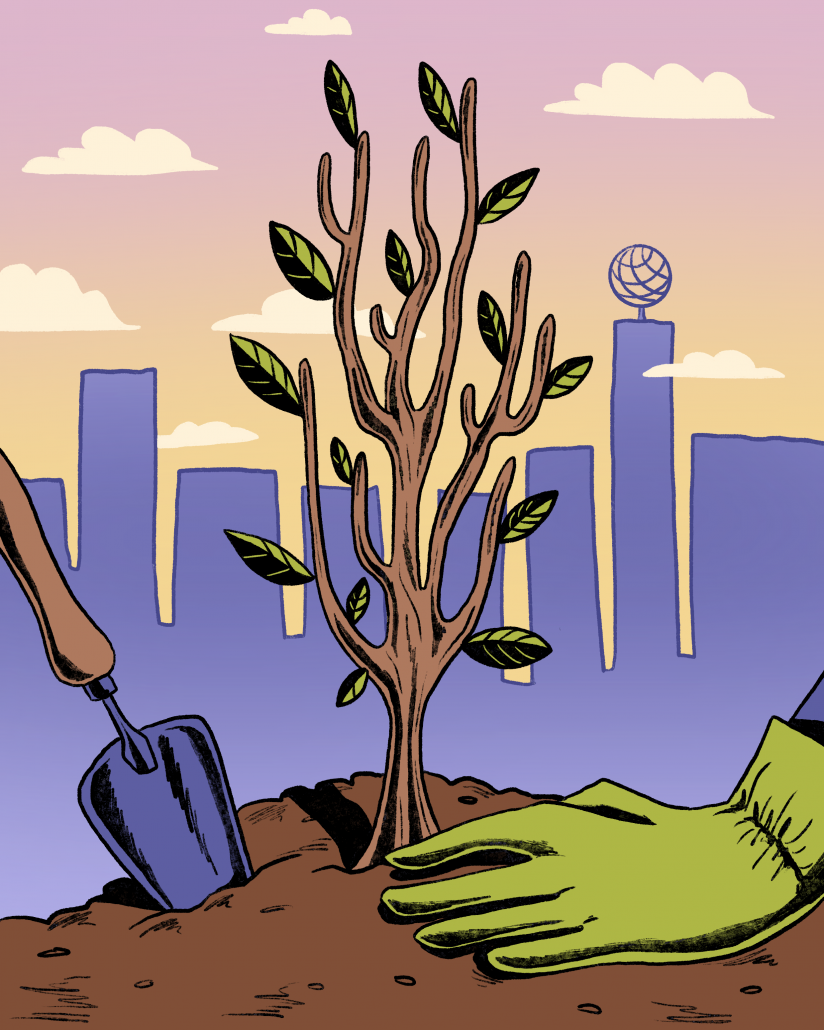Researchers collaborate with LA County to plant and maintain trees

In an area northeast of USC’s Health Sciences campus, there are about 22,000 trees. Each tree has been identified by species and size by members of the USC Urban Trees Initiative.
The USC Urban Trees Initiative has remotely recorded and analyzed a 3.5-square-mile zone block-by-block to provide data that could advise the Los Angeles community on where to plant and maintain trees to maximize benefits.
“The heart of this project is really providing valuable data that the city and other community groups can use to successfully plant trees,” said Kate Weber, executive director of the public exchange and founder of the project. “We’re developing a scientific roadmap that ideally makes the city’s urban forestry efforts in this area more effective.”
A collaboration between the Dornsife Public Exchange, Dornsife Spatial Sciences Institute, Dornsife Carbon Census Network and the Landscape Architecture Program at the USC School of Architecture, the initiative started in the Fall semester, aiming to provide relief from rising temperatures and the onset of global warming in L.A.
“What we’re interested in is trying to understand design options that would produce the best results in terms of reducing air pollution or improving stormwater recharge, or helping people handle extreme heat events,” said John Wilson, founding director of the Spatial Sciences Institute and project research lead. “Generally we rely on the idea that the more trees you have, the more influence you’re going to take out of the atmosphere and that may be true, but if you want to maximize the benefits of a certain kind of level of effort, then there’s some fundamental science that people haven’t done yet.”
Trees can have a significant impact on temperatures, especially in the L.A. community, where many houses were built during the 1940s and 1950s and are therefore lacking air conditioning. Finding the ideal spots to plant trees will provide the community with a resolution to combat the record-breaking temperatures in L.A. this past summer, according to Wilson.
The shade from trees affects the temperature and is also useful for pedestrians during times of extreme heat.
“Some of our colleagues went out with handheld thermometers and measured the temperature on the sidewalk,” Wilson said. “[The] difference in temperature just a few minutes apart in shade and out of shade was about 20 or 30 degrees Fahrenheit.”
By creating a scientific roadmap that advises the city of which species of trees to plant, where to plant them and how to maintain them, the project hopes to put the environmental relief plan to action.
“We had some community meetings and community members are saying, ‘Well, USC, where are you going to plant the trees?’ and it’s like ‘No, we’re not planting the trees.’ Our job is not to tell the city where to plant the trees,” said David Galaviz, associate vice president for government and community relations at USC’s Office of Governmental Relations.
Instead, Galaviz said the project’s job is to “work with the city to make sure that the planning of the trees is more efficient, and it’s more beneficial.”
Furthermore, Galaviz works to ensure that USC and the community are on the same page about how planting trees can help their neighborhood.
“What we hope to get out of this project and what we think we’re real close to achieving is a shared vision — a shared vision between the University and our students, which are critical players, a shared vision with our community members and our elected officials,” Galaviz said.
To achieve a shared vision, the project has been in contact with many groups who have different perspectives to provide insight on what more could be done.
“We had a series of virtual meetings with nonprofits, city council representatives and residents, where we talked about a variety of issues but got great input from the community on trees and needs in the area,” Weber said.
The eight staff members and four undergraduate students involved with the project worked closely with the community to gather the data to drive policymaking. The Spatial Sciences Institute students presented their work to city representatives in meetings and received feedback from the City’s Forest Officer.
So far, project members have built a base map for the study area, with public roadways, land use and knowledge of each block. The team has also gathered data on how many people live in the study area and their demographics, such as age cohorts and employment.
In addition, researchers studied the 22,000 trees in the area through advanced mapping technology such as Google Street View. Other earth sciences experts also utilized small portable sensors for air quality measurements to see what happened to air pollution, carbon monoxide and other conditions related to the environment, close to or far away from freeways around certain species of trees so they could learn more about which trees will provide the best benefits for the city.
“I think those kinds of experiences for the students [are] the icing on the cake, because they get to see a project from its inception to its finish in almost every aspect,” said Wilson.
The project expects to finish their research by the end of March and announce findings in April.
The city of L.A. is an international leader on sustainable economic development and on sustainable community building, according to Galaviz. USC’s involvement in this project allows L.A. to move forward with their Green New Deal plan which started in 2019.
“USC is front and center in the city’s push to become more sustainable and more forward thinking,” Galaviz said. “This project is really an example of how USC academic research can really illuminate city policy and really create benefits. And a key component of that is our students, because they’re front and center, doing the research, pushing this forward.”

